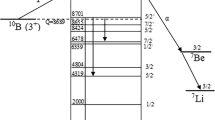Summary
The radiations from152Eu (t1/2=13 yrs) were investigated using an intermediate image spectrometer, a magnetic thin lens spectrometer and a coincidence scintillation spectrometer. Three β--groups are present with end-points (1450±25), (1040 ±20), (710±20)keV; the highest energy group exhibits an α-shape. γ-ray investigations showed that the following γ-rays are present: 101 (5), 121 (88), 244 (30), 315 (4), 344 (100), 410 (9), 442 (4), 710 (13), 770 (77), 888 (14), 970 (89), 1090 (96), 1127 (96) and 1410 (135) keV.K-conversion coefficients were estimated for most of these transitions and multipole orders were assigned. X-ray-γ, γ-γ and β-γ coincidence experiments allow us to construct the decay scheme of152Eu. The difference in level structure in152Sm (N=90) and152Gd (N =88) is evident from the experimental results. The first three excited states at 121, 365 and 807 keV in152Sm are identified as the three members of the ground state rotational band (K=0) ; the levels at 1090 and 1248 keV havingI= 2 +, and 3 + respectively are shown to be the quadrupole γ-vibrational states corresponding to K=2. The highest excited state in152Sm is at 1417 keV and is most likely fed entirely byL-capture; this is the only odd-parity state in152Sm having the character I=1-. The levels in152Gd at 344 and 754 keV both with I=2 +, reached by β--decay, are characteristic of the collective vibrations of the electric quadrupole type about a spherical equilibrium shape. The level at 1114keV in152Gd has the character I=— and is interpreted as due to the octupole vibrations. The ground state of152Eu has been assigned the spin I=4 -; the branching ratios and the transition probabilities for the β--groups and electron capture transitions have been calculated. The experimental results are consistent with the predictions of the Unified Nuclear Model.
Riassunto
Le radiazioni del152Eu (t1/2=13 anni) sono state studiate usando uno spettrometro a immagine intermedia, uno spettrometro a lente magnetica sottile e uno spettrometro a coincidenze a scintillazione. Si constatano tre gruppi β- terminanti a 1450±25, 1040±20, 710±20 keV; il gruppo di energia massima ha forma α. Opportune ricerche, mostrarono la presenza delle seguenti radiazioni γ: 101 (5), 121 (88), 244 (30), 315 (4), 344(100), 410(9), 442(4), 710(13), 770(77), 888(14), 970(89), 1190(96), 1027(96) e {dy1410} (135) kV. I coefficienti di conversioneK sono stati stimati per la maggior parte di queste transizioni e sono stati assegnati gli ordini dei multipoli. Esperienze di coincidenza raggi X-γ, γ-γ e β-γ ci permettono di costruire lo schema di decadimento del152Eu. La differenza nella struttura dei livelli del152Sm (N=90) e152Gd (N=88) risulta evidente dai risultati sperimentali. I primi tre stati eccitati del152Sm a 121, 365 e 807 keV si identiflcano come le tre parti della banda rotazionale dello stato fondamentale (K = 0); i livelli a 1090 e 1248 keV conI = 2 +, e 3+ rispettivamente, si dimostrano essere gli stati vibrazionali γ di quadrupolo corrispondenti a K=2. Lo stato eccitato più elevato del152Sm si trova a 1417 keV ed è probabilmente alimentato completamente per catturaL; è questo l’unico stato con parità dispari del152Sm avente carattere I=1-. I livelli del152Gd a 344 e 754 keV, ambi con I=2+, raggiunti col decadimento β- sono caratteristici delle vibrazioni collettive di tipo quadrupolo elettrico intorno a una configurazione d’equilibrio sferica. Il livello a {dy1114} keV del152Gd ha caratteristica I=— e si ritiene dovuto alle vibrazioni da ottupolo. Allo stato fondamentale del152Eu è stato assegnato lo spin I=4-; si sono calcolati i rapporti e le probabilità di transizione per i gruppi β- e le transizioni per cattura elettronica. I risultati sperimentali si accordano con le previsioni del modello nucleare unificato.
Similar content being viewed by others
References
R. E. Slattery, D. C. Lu andM. L. Wiedenbeck:Phys. Rev.,99, 1615 (1955).
L. Grodzins:Bull. Am. Phys. Soc.,1, 163 (1956).
O. Nathan andM. A. Waggoner:Nuclear Phys.,2, 548 (1957).
S. K. Bhattacherjee andS. Raman:Nuclear Phys.,4, 44 (1957).
K. Alder, A. Bohr, T. Huus, B. Mottelson andA. Winther:Rev. Mod. Phys.,28, 523 (1956).
P. Brix andH. Kopfermann:Phys. Rev.,85, 1050 (1952).
P. Brix:Zeits. Phys.,132, 579 (1952).
N. P. Heydenberg andG. M. Temmer:Phys. Rev.,100, 150 (1955).
W. H. Johnson andA. O. Nier:Phys. Rev.,105, 1014 (1957).
B. R. Mottelson andS. G. Nilsson:Phys. Rev.,99, 1615 (1955).
J. M. Cork, M. K. Brice, R. G. Helmer andD. E. Sarason:Bull. Am. Phys. Soc.,2, No. 1, E316 (1957).
T. D. Nainan, H. G. Deware andA. Mukerji:Proc. Ind. Acad. Sc.,44, 111 (1956).
J. M. Hill andL. R. Shephard:Proc. Phys. Soc., A63, 126 (1950).
M. E. Rose, G. H. Goertzel andC. L. Perry: ORNL-report 1023 (1951).
A. W. Sunyar:Phys. Rev.,98, 653 (1955).
L. Grodzins andH. Kendall:Bull. Am. Phys. Soc.,1, No. 4, 164B11 (1956).
G. Scharff-Goldhaber andJ. Weneser:Phys. Rev.,98, 212 (1955).
F. S. Stephens, P. Asaro andI. Perlman:Phys. Rev.,96, 1568 (1954).
L. Grodzins:Bull. Am. Phys. Soc.,1, No. 7, 329J7 (1956).
G. Alaga, K. Alder, A. Bohr andB. R. Mottelson:Kgl. Danske Videnskab. Selskab. Mat. fys. Medd.,29, No. 9 (1955).
Author information
Authors and Affiliations
Rights and permissions
About this article
Cite this article
Bhattacherjee, S.K., Nainan, T.D., Raman, S. et al. Decay of152Eu and the unified nuclear model. Nuovo Cim 7, 501–523 (1958). https://doi.org/10.1007/BF02747764
Received:
Published:
Issue Date:
DOI: https://doi.org/10.1007/BF02747764




